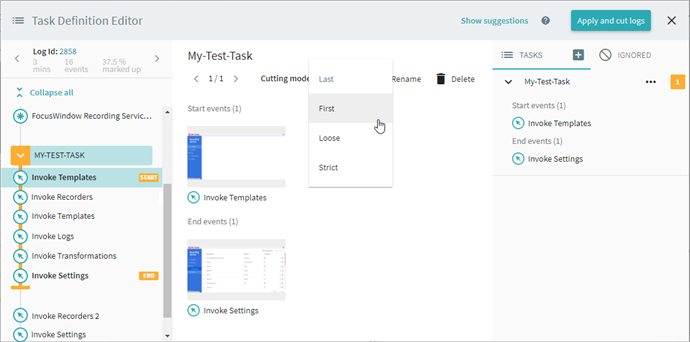Cutting Mode
It is important to select the correct cutting mode for a task. Cutting modes let you automatically define tasks containing many events similar to the start and end events.
For logs with a lot of similar events:
- You should have already specified the start and end events before cutting.
- The program will then automatically detect and select all instances of those events in the log.
- Depending on the selected cutting mode, the program will automatically modify the task boundaries by choosing the appropriate start and end events itself.
All such changes will be displayed in Task Definition Editor.
EXAMPLE - How to use cutting mode
The operator needs to fill in a form. During the last step of the task, the operator clicks a Submit button. This is reflected in the logs by an Invoke submit event. Next, the operator makes a correction in the form and clicks Submit again, which is also reflected by another Invoke submit event. In order for these logs to be processed correctly, the Last cutting mode needs to be used. This mode will place all such form submissions within the boundaries of the selected task.
To set a cutting mode, select a task either in the Tasks pane on the right or in the log pane on the left. The Task Manager pane will appear in the center of the form. Select the appropriate mode from the Cutting Mode drop-down list.

The following cutting modes are available:
- Last — The log will be cut at the last start event and at the last end event.
IMPORTANT NOTE: The Last cutting mode is selected by default. - First — The log will be cut at the first start event and at the first end event.
- Loose — The log will be cut at the first start event and at the last end event.
- Strict — The log will be cut at the last start event and at the first end event.
Using different cutting modes on the same event sequence
The table below represents a sequence of events defined into the same task by different cutting modes.
Each column represents the same set of events.
The Invoke Templates event has been set as the start event, and the Invoke Settings event has been set as the end event. In the source sequence, both of these events occur several times. Columns 2 to 5 show how each cutting mode would define the task from the sequence. Events in italics will be excluded from the event, while the rest will be placed within its boundaries.
| Initial sequence | Strict (last start, first end) | Loose (first start, last end) | First (first start, first end) | Last (last start, last end) |
|---|---|---|---|---|
| FocusWindow Recording Service | FocusWindow Recording Service | FocusWindow Recording Service | FocusWindow Recording Service | FocusWindow Recording Service |
| Invoke Templates | Invoke Templates | Invoke Templates | Invoke Templates | Invoke Templates |
| Invoke Recorders | Invoke Recorders | Invoke Recorders | Invoke Recorders | Invoke Recorders |
| Invoke Templates | Invoke Templates | Invoke Templates | Invoke Templates | Invoke Templates |
| Invoke Logs | Invoke Logs | Invoke Logs | Invoke Logs | Invoke Logs |
| Invoke Transformations | Invoke Transformations | Invoke Transformations | Invoke Transformations | Invoke Transformations |
| Invoke Settings | Invoke Settings | Invoke Settings | Invoke Settings | Invoke Settings |
| Invoke Recorder 2 | Invoke Recorder 2 | Invoke Recorder 2 | Invoke Recorder 2 | Invoke Recorder 2 |
| Invoke Settings | Invoke Settings | Invoke Settings | Invoke Settings | Invoke Settings |
9/22/2023 8:59:47 AM